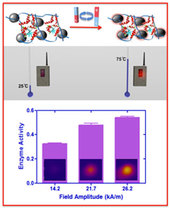Highlight
Remotely activating biological materials with nanocomposites
Achievement/Results
The heating properties of iron oxide nanoparticles have been exploited through the years for use in cancer therapy, gene regulation, and temperature responsive valves. These applications have demonstrated the versatility of iron oxide nanoparticles, but they had rarely, if ever, been used to enhance the activity of thermophilic enzymes. Thermophilic enzymes are highly stable biomolecular systems that are excellent tools due to their thermostability and long-term activity for extended lifetime uses in the field and other applications. Traditionally, these enzymes are heated in an oven or water bath at a specified temperature. These heating methods are not efficient and much of the heat can be lost due to diffusion limitations of the heat to the sample.
Work by IGERT trainee, Leslie Knecht addresses the problem of remotely activating biological materials with a higher efficiency than conventional methods such as water baths or convection ovens. In this work, a hydrogel is fabricated which includes a chemically immobilized thermophilic dehalogenase and encapsulated iron oxide (Fe3O4) nanoparticles. Previous studies have shown that these nanoparticles heat up when in the presence of an alternating magnetic field (AMF). Knecht used the hydrogel nanocomposites in the AMF to find the field strength for optimum enzymatic activity. Additionally, she heated the hydrogel nanocomposites in a water bath at the optimal temperature for enzymatic activity. Comparing these results, it was found that the enzyme was two times more efficient when heating in the AMF as compared to heating in a water bath in one-third of the time.
Address Goals
This is the first study of its kind that has demonstrated the use of localized heating with iron oxide nanoparticles to enhance the activity of thermophilic enzymes. It is envision that this method could be expanded for personalized therapeutics, bioremediation, catalysis, filtering devices, separations, etc. In short, this application could be potentially applied to any system where you need to turn on and off bioactivity.






